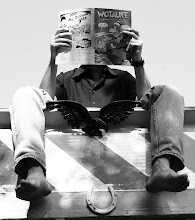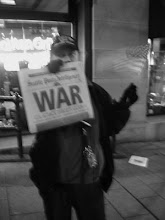
I held Walt Whitman in my arms that day I first found him, sequestered within the dirty, dusky confines of an antique mall located in a turn-of-the-century feed barn in the tiny borough of Harmony, Pennsylvania, a settlement founded in 1804 by German pietist Johann Georg Rapp.
It was spring and he was lying on his back, held fast beneath an overbearing J. Edgar Hoover, his spine abutting that of a haggard-looking Vincent Van Gogh. He came cheaply, costing me less than I would shell out for a decent road map today. They all, in fact, came easily, and so I took them, Walter, Edgar, and Vincent, cradling them against my chest, atop nameless others, carrying them from the barn, into the daylight of a time they would never know, a world where, perhaps, their individual wounds of repression and guilt and torment would be allowed some healing. I brought them home, opened them up, and let them into my life, each for a different reason, each serving a purpose of their own.
Of all my new companions, I soon grew most enamored of the old man, the poet with the haywire, paper-white beard, the sleepy, morning eyes, the quietly devilish crook of a nose. I sought not to judge him, only to show respect for the effort he put forth in building a life from nothing more substantial than his own muse, but what I subsequently learned of his nature lead me to question and challenge him, just as I had done his moral counterpart, Herbert George Wells, some half dozen years before, when I found the father of modern science fiction coupling with tawdry imposters on a greasy metal shelf in Pittsburgh. For every hour of fading day that Whitman pondered the lines of the hands upon his lap, secretly picturing those of another, Wells was dragging his adulterous carriage across numerous bed chambers, letting loose his boisterous seed, a discharge of genius and pomposity.
“There's old H.G. Wells, lying in bed with his new housekeeper, hot squid by their side, glowing with pride, flushed with exhaustion” – Robyn Hitchcock, from his song “Victorian Squid”.
This was 1990, a time of encroaching moral repression in the rural township in which I lived. Even though the evangelical Christian crusaders of The Moral Majority had all but dissolved their organization by the time George Herbert Bush stepped into the White House, there was a righteous fever in the air about my community, a heated desire to vanquish all heathen urges, America’s puritan heart reasserting itself at the end of the century.
These signs of a “Babylonian collapse” materialized themselves as a small, concrete-block building on the old highway running directly south to Pittsburgh. This bunker-like structure held our township’s very first adult book shop. It didn’t take long for a local, torch-wielding mob to form, gathered about the fervent ministrations of a local man of the cloth. Soon, they had the police making regular raids upon the tiny business, eventually arresting the tending clerk for selling immoral materials, a nefarious charge stemming from recently-drawn anti-obscenity laws. It didn’t seem to bother any of the moralist vigilantes that the individual who took the brunt of their attack, who spent more than a few months in prison, was a fifty eight year-old grandmother.
Angered and frustrated by these events, I one day noticed a new billboard, appointed roadside prominence not more than two miles from where the now-shuttered bookstore stood. It was part of a national campaign designed to humiliate the “users” of pornography, to shame those who, through personal and societal circumstance, sought to facilitate their natural sexual compulsions the only way available to them: through magazines and films. One tag line of this witch hunt, “Real Men Don’t Use Porn”, was emphasized with a line-up of stern-looking women, Olympic Gold Medalist Jackie Joyner Kersee among them, all standing shoulder-to-shoulder, looking out from the gaudy tableau of outdoor signage, giving all who passed by the reproachful stare of a shocked and disapproving schoolmarm. This atmosphere of moral turgidity swirling about me, I immersed myself in the book which was resting atop the tall pile I’d exited the dark antiques emporium with that late spring day; Walt Whitman, A Life, by the masterful biographer, Justin Kaplan.
An astonishingly intimate and admiringly thorough account of the life of America’s “poet of democracy”, this 432 page volume led to my reading and absorbing all I could of Whitman, revisiting the weathered paperback copy of Leaves of Grass I’d had since my early teens, steeping myself in what I soon realized was an ultimately sad and repressed existence, Whitman never being able to make tactile his longing for the young men who accompanied him on his various literary pursuits and undertakings. His was a desire uncorked, passion left to simmer and boil its way into the very heart of his poetry, those magnificent, earthy, delicately-rooted plots of verse that evoke so much of what he dared not speak with his tongue. It was only a matter of time before these fascinating realizations found their way into my cartooning.
I began in 1993, with “Walt Whitman’s Super-Hero Daydream”, appearing in the first issue of Whotnot!, my quarterly comic from Fantagraphics. Here I offered a coy commentary on Whitman’s self-repression, as viewed through the lens of Dr. Fredric Wertham’s infamous Seduction of the Innocent, his investigation of the “morally-unhinged” comic book industry, harbinger to the 1954 Senate Committee Hearings to Investigate Juvenile Delinquency, and the industry’s formation of its own dubious Comic Code Authority. It was a cartoon I was later informed had been enjoyed so much by a literature professor at Auckland University that he’d photocopied and enlarged it, displaying it on his classroom wall. The next Whitman piece I felt compelled to create was entitled “Young Walt Sees A Skull With Hair On It”, a somber, one-page rumination on the poet’s early career in journalism, a cartoon I shelved, deciding it wasn’t appropriate for the tone of Whotnot! I next utilized Whitman in 1994, featuring him as one of four sad sack bards in “Poetry Does Not Pay”, a centerpiece from Whotnot! #4, the last issue of the series. This was a four-page parody of the pre-Wertham crime comic milieu, specifically the title Crime Does Not Pay and its strident, righteous tone, one ironically echoed in the “Real Men Don’t Use Porn” campaign. A year later, I eventually found a home for “Young Walt”, placing it in the first issue of my new series, A World Of Trouble, published by Black Eye Productions.
It was this story in particular that recently caught the interest of Robert A. Emmons Jr., Associate Director of the Honors College at Rutgers University-Camden, and a teacher of film, media studies, and comics history. As a regular contributor to the respected online academic journal, Mickle Street Review, a quarterly publication dedicated to the study and illumination of Walt Whitman’s work and life, Emmons has written a exceptionally thorough examination of the three above-mentioned cartoons and my work-born relationship with the man who is held by many to be America’s foremost poet of the emotional, that ever-confounding and fascinating junction of what we call the brain and the heart. I recommend visiting Mickle Street Review Issue 19/20: Sights and Sounds, where you will find Emmon’s insightful piece, as well as many other fascinating articles upon the influential poet.
























































